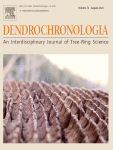Ver ítem
- xmlui.general.dspace_homeCentros Regionales y EEAsCentro Regional Patagonia NorteEEA BarilocheArtículos científicosxmlui.ArtifactBrowser.ItemViewer.trail
- Inicio
- Centros Regionales y EEAs
- Centro Regional Patagonia Norte
- EEA Bariloche
- Artículos científicos
- Ver ítem
Effects of climate on the radial growth of mixed stands of Nothofagus nervosa and Nothofagus obliqua along a precipitation gradient in Patagonia, Argentina
Resumen
Climate models for North Patagonia in Argentina project dryer conditions, due to a decrease in mean precipitation combined with an increase in mean temperatures. The temperate mixed Nothofagus forest, which exists along a steep precipitation gradient, could be directly impacted. For this study, we evaluated the influence of mean climate on the growth of the significant deciduous species: N. nervosa and N. obliqua. For the first time in Argentina,
[ver mas...]
Climate models for North Patagonia in Argentina project dryer conditions, due to a decrease in mean precipitation combined with an increase in mean temperatures. The temperate mixed Nothofagus forest, which exists along a steep precipitation gradient, could be directly impacted. For this study, we evaluated the influence of mean climate on the growth of the significant deciduous species: N. nervosa and N. obliqua. For the first time in Argentina, dendroclimatological analyses were done on both species using a network of 14 chronologies, covering their longitudinal distribution along a gradient of declining precipitation from west to east. Seasonal correlation analysis revealed that temperature has a negative effect on the growth of both species across all sites, particularly during summer of the previous and current growth season. Precipitation has a positive effect on the growth of trees for both species, which is more significant for N. nervosa. The relationship between early-summer climate and growth remained relatively stable over time for N. nervosa; however, for N. obliqua the detrimental effects of temperature increased towards the end of the 20th century, and the positive effects of precipitation decreased, particularly at the driest end of the gradient. These results suggest that a continued decrease in rainfall with a rise in temperature could impact growth for both of these species.
[Cerrar]

Autor
Bonada, Anabela;
Amoroso, Mariano Martin;
Gedalof, Ze’ev;
Srur, Ana;
Gallo, Leonardo Ariel;
Fuente
Dendrochronologia 74 : 125961. (August 2022)
Fecha
2022-08
Editorial
Elsevier
ISSN
1612-0051
1125-7865
1125-7865
Formato
pdf
Tipo de documento
artículo
Palabras Claves
Derechos de acceso
Restringido
 Excepto donde se diga explicitamente, este item se publica bajo la siguiente descripción: Creative Commons Attribution-NonCommercial-ShareAlike 2.5 Unported (CC BY-NC-SA 2.5)
Excepto donde se diga explicitamente, este item se publica bajo la siguiente descripción: Creative Commons Attribution-NonCommercial-ShareAlike 2.5 Unported (CC BY-NC-SA 2.5)


